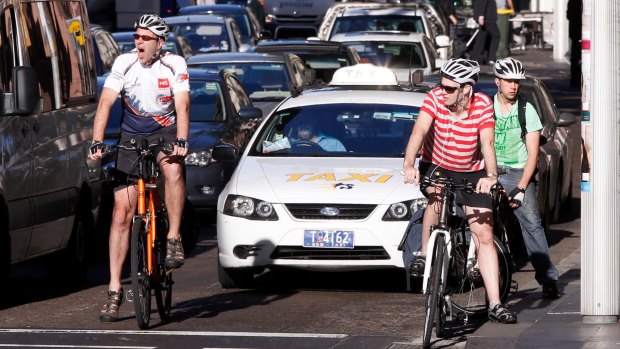The number of fines handed to cyclists in NSW surged by more than a third in the first year of stiffer penalties, which led to the state government collecting more than $2.2 million in revenue from the top-five offences.
Almost two-thirds of the 9760 infringement notices issued in the 12 months after the new laws were introduced were for failing to wear helmets, the fine for which quadrupled to $319 on March 1 last year.
It resulted in $1.99 million flowing into government coffers from people caught cycling without helmets in the first year of the higher penalties, compared with about $337,000 in the same period a year earlier.
In contrast, the penalties copped by motorists for failing to pass cyclists at a safe distance was 17 for the year – up from 10 in the prior period.

NSW has some of the highest fines in the world for cycling offences.Credit: Anthony Johnson
Motorists who do not allow a distance of at least one metre from a cyclist when the speed limit is 60km/h or less, and 1.5 metres when the limit is more than 60km/h, attract a fine of $330 and two demerit points.
Figures from Revenue NSW show the total number of penalty notices issued in the state for cycling offences rose by 38 per cent to 9760 in the 12 months to February, compared with the same period a year earlier. The total includes those for "wheeled toys or other non-motor vehicles" such as skateboards.
The government introduced some of the highest fines in the world for cycling offences last year, which included a near five-fold increase in the penalties for running a red light or riding dangerously to $425.
The number of cyclists fined for red-light offences rose by 22 per cent to 849 for the year to February.
The $2.25 million collected by the government for the top-five offences in the first 12 months of the new laws dwarfed the $429,000 it gained from those same penalties in the prior period. About 90 separate offences cover bicycles, "wheeled toys and other non-motor vehicles".
While figures on accidents for the entire year are not yet available, those for the first 10 months of the new regulations show the total number of injuries to cyclists fell by about 7 per cent to 1858, compared with the same period a year earlier.
Serious injuries dropped by 6.5 per cent to 1506 for the 10-month period, according to statistics from the NSW Centre for Road Safety.
The centre's executive director, Bernard Carlon, said there had been a steady decline in serious injuries to cyclists since 2015.
"Sadly in 2016 five cyclists died on NSW roads, and although this was five too many, it was down from seven deaths in 2015. This was the lowest number of bicycle rider fatalities on record," he said.
While injuries have been declining in recent years, the interest in cycling also appears to have been on the wane in NSW.
A national survey released in June showed a drop in people in NSW riding in a typical week to 12.5 per cent this year, from almost 17 per cent in 2015. NSW has the lowest participation rates for cycling of any state or territory in Australia.
The state's cycling fines increased on July 1 at the rate of inflation, taking the penalty for not wearing a helmet to $330; running a red light to $439; riding negligently, furiously or recklessly to $439; and failing to stop at a pedestrian crossing to $439.